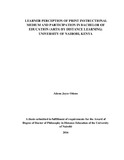| dc.description.abstract | This study undertook to establish Learner perception of Print Instructional Medium and Participation in Bachelor of Education (Arts) by Distance learning: University of Nairobi, Kenya. Kenya has witnessed an increase in demand for higher education. This demand has led to the growth of Open and Distance learning institutions. These institutions act as a stop gap to fill the need for higher education by the populace since the traditional mainstream institutions are not able to cope with the high demand. Distance learning originated from Europe as correspondence courses at Pitman and the London University. It later spread to America and the rest of the world. The aim has always been to avail education to as many people as possible who need it. The University of Nairobi has been the leader in Open and Distance learning (OdeL) in Kenya. Its activities date back to 1953 when the first department of extramural studies was founded in Makerere with a resident tutor for Kenya. Distance learning relies on a media for purposes of delivering content to the learner. The media act as the instructor. This study focused on print instructional medium in the form of study units since it is the most commonly used in the delivery of distance learning at the University of Nairobi. The target population was 547 parts six students registered at the School of Continuing and Distance Education. The sample size was 231 who were randomly selected for the study. The study also targeted 11 full time and 15 part time lecturers and 1 distribution officer from the printing shop. The total sample was 256. The study was guided by six objectives which were: to establish influence of content of print instructional medium on learner participation in distance learning, to determine the influence design of print instructional medium on learner participation in distance learning, to examine the influence of availability of print instructional medium on learner participation in distance learning, to assess combined influence of content, design and availability of print instructional medium on learner participation in distance learning, to determine the moderating influence of learner characteristics on participation in distance learning and to assess the moderating influence of learner support services on participation in distance learning. The study adopted mixed method approach. Mixed method approach was deemed suitable for the study because the data collected were both qualitative and quantitative in nature. Research instruments used included questionnaires, interview guide, content analysis guide and document analysis guide. Data collected were analyzed using descriptive statistics such as means, percentages and standard deviations whereas inferential statistics used to test hypothesis were chi- square, regression, Pearson’s correlation and ANOVA. The study was set at 95% confidence level and the decision to accept or reject the null hypothesis was based at 0.05 levels of significance. The result on learner perception of content show that 80% of the respondents agreed that content influences their participation in distance learning. The hypothesis which stated that content of print instructional medium has no influence on learner participation in distance learning was rejected since (F =9.629, P<0.05 at 0.002). Results on influence of design on learner participation reveals that 83.1% of the respondents agreed that design of study units influences their participation in distance learning. The hypothesis which stated that design of study units has no influence on learner participation in distance learning was rejected since F=10.495, P<0.05 002. Findings on availability of study units show that 79% perceive study units as very important for their study but they would participate
xvi
whether they are available for them or not. We failed to reject the hypothesis which stated that learner perception of availability of study units has no influence on learner participation since the results show that F=0.828, P>0.05 at 0.364. Results on learner support services show that they do moderate learner participation in distance learning since 80% of the respondents view them as very important component of their participation in the program. The hypothesis which stated that learner support services have no influence on learner participation was therefore rejected since F=5.244, P<0.05 at 0.000. Multiple regressions done on the variables of the study revealed that learner support services were the most important for learner participation in distance learning. The conclusion made was that Print instructional medium used in the delivery of distance learning at the University of Nairobi influences learner participation in distance learning. There is therefore need to review the content of study units since the content is not up to date. There is also need to make icons in the study units relevant to the learners since they form an important aspect of print instructional design. Farther policy makers should address the issue of availability of study units. They should be made available on time so that learners have adequate time to interact with them as they participate in the program. | en_US |



